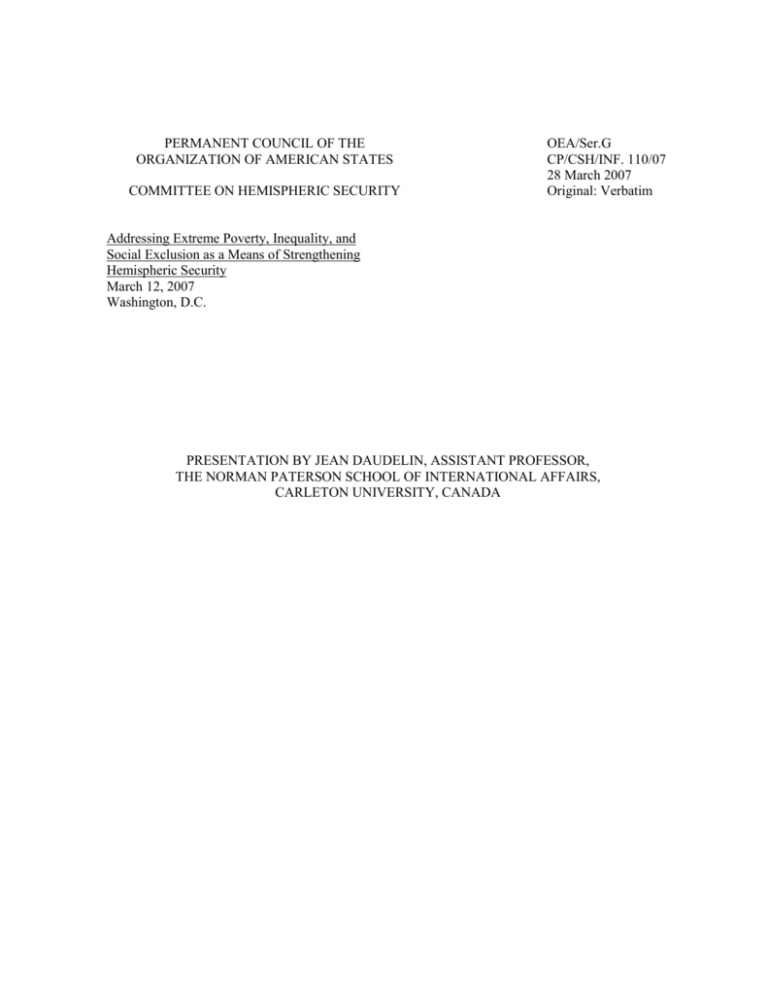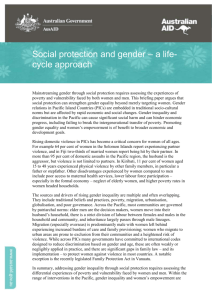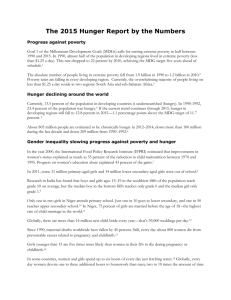Prospects for Cooperation on the Multidimensional Security Agenda
advertisement

PERMANENT COUNCIL OF THE ORGANIZATION OF AMERICAN STATES COMMITTEE ON HEMISPHERIC SECURITY OEA/Ser.G CP/CSH/INF. 110/07 28 March 2007 Original: Verbatim Addressing Extreme Poverty, Inequality, and Social Exclusion as a Means of Strengthening Hemispheric Security March 12, 2007 Washington, D.C. PRESENTATION BY JEAN DAUDELIN, ASSISTANT PROFESSOR, THE NORMAN PATERSON SCHOOL OF INTERNATIONAL AFFAIRS, CARLETON UNIVERSITY, CANADA Poverty and inequality as security challenges in the Americas Jean Daudelin The Norman Paterson School of International Affairs Carleton University Notes for a presentation to a Meeting of the Committee on Hemispheric Security of the Permanent Council of the Organization of American States, devoted to "Addressing Extreme Poverty, Inequality, and Social Exclusion as a Means of Strengthening Hemispheric Security." Conference draft. Please do not quote without the author's permission March 12, 2007 Washington, D.C. jean_daudelin@carleton.ca POVERTY AND INEQUALITY AS SECURITY CHALLENGES IN THE AMERICAS The theme of this special session neatly summarizes an understanding that remains dominant in policy circles and that still has significant influence in academia. According to that view, poverty and inequality are very important and possibly fundamental "root causes" of social tensions, violence and conflict. Addressing those issues, at the domestic or international level, is thus often seen as the best way to sustainably address not only the symptoms, but also the very origin of insecurity. Quite a bit of evidence, and a growing body of literature, however, suggest that this understanding could very well be wrong or that, at least, it might only be right in a peculiar way. The policy implications of some of that work are also quite different from those that flow from the root causes perspective. If the critics are right, many policy initiatives, both domestic and international, might at best be ineffective in the fight to make the world, or for our purpose the Americas, as free as possible from violence and insecurity. In this very brief presentation, I would like to examine the problems of poverty and of inequality as determinants of insecurity from the standpoint of some of that new work, more particularly by building freely on the works of Paul Collier and his colleagues, on poverty and grievances; and of Frances Stewart, from Oxford, on horizontal inequality. Now, these two British development economists, whose recent work I consider particularly interesting, are both specialists of Africa, and much of their work –though by no means all of it- refers to Africa and can also be seen as particularly relevant to Sub-Saharan Africa. What I will do is try to see how their intuitions can help us understand the specific challenges that confront us, in the Americas Let me emphasize that the academic debate about development and conflict is lively with new cases and new data being brought to bear on a regular basis. In all honesty, there is still very little consensus on the determinants of conflict and of insecurity. As a result my analysis, as well as policy guidelines that flow from it should thus be seen as highly tentative. An important little caveat is in order before I start the discussion: security is understood here as protection from physical violence. I know that a lot of recent work on human security, in academic circles, but also in foreign ministries and international organizations, has been promoting, under the concept of human security, a much broader understanding of security, one that would address -2- basically all possible sources of fear for people. I am not sure that this is useful, hence my narrower and more traditional take on the problem.1 1- Poverty Poverty as a root cause? Intuitively, the notion that poverty leads to violence and revolt is very appealing: "if I were in that situation, reasons the honest woman, I would indeed rob, kill, or main." There is also some supportive evidence. As a rough start, there is a global correlation between poverty and conflict since World War II: a large number of the poorest countries of the world are currently at war, or have been in the recent past. Most of the countries at war over the last twenty five years have been poor countries, in a large number of cases, extremely poor ones. Think of Afghanistan, Sierra Leone, the Democratic Republic of Congo and much of Sub-Saharan Africa. Closer to us, think of Haiti, which never quite seems to be able to escape violence and repression. In the research he did for the World Bank, Paul Collier has indeed shown that extreme poverty is quite a good predictor of conflict. His explanation for that result, however, has very little to do with the frustration-aggression assumption that underlies much previous work on poverty and violence. As a mechanism linking the two, Collier has pointed instead to the lack of appealing economic alternatives to violence for young men, and to the limitations imposed by a narrow tax base to government capacity to guarantee order. The mechanism, in other words, is indirect. It works through two things. First it works through the incentive for some people, in this case primarily young men, to join an insurgency or a criminal gang because it offers better economic rewards than they would get on the job market. Second, it works through the relative ability of the state to effectively monopolize violence and guarantee order on its territory, which, being relative also depends on the ability of others to mount a challenge. That ability, in turn, depends crucially on the resources that 1. Moreover, if we were to understand extreme poverty or social exclusion, for instance, as in themselves situations of insecurity, the whole exercise of this committee would become meaningless: if poverty IS insecurity, addressing its impact on insecurity becomes inconsistent logically. I adopt the same stance on violence, refusing to cross into the debate about "structural violence" which would throw us back to circularity in a discussion of the relationship between extreme poverty, which, if understood as "structural violence," can hardly be seen as a cause of it. -3- they can access: domestically or internationally. The problem, in other words, revolves around the relative capacity of the state, on one side, and of those who violently challenge its rule, on the other. Poverty defines part of the context in which this contest takes place. What Collier's work suggest is that in extremely poor countries, what one could call the balance of enforcement between the state and its violent challengers is easier to tip in favour of the challengers than it is in richer countries. The Sandinistas and the FMLN went a long way with a few bank robberies and some still not fully documented support from friends abroad. Others in West Africa and Asia have done the same with diamonds or with money sent in by diasporas. During the Cold War, obviously, just about any insurgent group could get support, depending on who was in power in their country, from the United States or, directly or not, the Soviet Union. When countries are richer, much more resources are needed to challenge the state's ability to guarantee order on its territory, which explains to a large extent why insurrections and large-scale criminal violence are less prevalent in wealthy countries. As we know very well however, even in relatively wealthy countries states can have a hard time keeping the balance in their favour. Which is precisely what takes us back to the Americas, to suggest that here, for the most part, poverty is not the most important factor in the tipping of that balance, drug trafficking is. Poverty, drugs, and violence in the Americas As I just said, in richer countries, more resources are needed to challenge the state's ability to impose order and deter the use of violence in its territory. Now the problem with our continent is precisely that much more resources ARE in fact available to challengers, primarily because of the drug trade. Revenues from illegal drug trade is the major factor that enables violent actors to challenge state authorities in the Americas. The amounts are such that even moderately poor people or middleclass individuals can be enticed into illegal activities. They are so large that gangs can procure amounts of firepower that put many state authorities to shame. Even in countries whose tax base is massive, drug gangs are often able to carve out, sometimes quasi-permanently, whole territories. Obviously, in Haiti, Bolivia or Nicaragua, criminal gangs involved in drug trafficking will have a field day, playing on the misery of the people, the weakness of the state, or both. Given what -4- happens in Brazil, in Colombia, or for that matter in Canada and the United States, it would be naive, however, to trace drug-related violence, which is arguably the continent's most important security challenge, to poverty. Something beyond development policy is needed here. My own inclination points to legalization. From the standpoint of security such a measure would have a massive impact on the balance of power between states and their violent challengers: the latter would see their main source of revenue dry out, and states would see their own tax base increase significantly while the requirements for the management of now poorer criminals would likely decline. I know that this option is not really on the table, to a large extent because of opposition from the United States. Now, understand me well: I am not saying that legalization is a panacea. It only has the potential to help deal with the public order side of the issue, leaving the health and social dimensions of the drug problem unaddressed. Still, until that option is put on the table, I can't see how we can seriously address the problem of the linkage between poverty and insecurity in the hemisphere. Now to the second of our two issues... 2- Inequality What inequality is a root cause of conflict and violence? Like the poverty as a root cause thesis, this one makes a lot of intuitive sense: confronted to the huge wealth of the few, to their huge apartments, luxury shopping centres and guarded ghettos, can we not understand many poor Latin Americans, many of whom can barely feed their children or provide them with adequate schooling and health care, for taking to the streets, demonstrating violently and sometimes joining revolutionary groups or criminal gangs? Once again, these views have found support in some academic research–most famously Ted Gurr's, whose "relative deprivation" thesis remains a point of reference in the scholarly discussion. Empirical work, however, has not been very supportive of the idea although, as usual, much debate surrounds these studies. Collier and Hoeffler found inequality to be a very poor predictor of conflict. Oxford's Frances Steward got the same general results but added a twist to the story, which -5- brings inequality back as a determinant of conflict and violence: instead of looking at inequality between individuals or abstract revenue categories, she and her team looked at differences between self-identified groups, primarily along ethnic and racial lines. She found "horizontal inequalities", i.e. inequalities between those groups, to be highly correlated with conflict. In addition to the robustness of her results, the advantage of her hypothesis is that it neatly meshes with a lot of work done on mobilization and collective action. This work suggests that ethnic identity makes the setting up of social movements and organizations easier, because the presumed kinship involved increases trust, which in turn lessens coordination, information and control costs. What she suggests is that whatever frustration might be produced by inequality, it is much easier to channel into a violent action when it is perceived to affect people as members of a group with which they identify, than as member of abstract class or social categories. Note that, distinct from our discussion of the balance of enforcement, above, this driver of violence is primarily associated with political mobilization, not criminal violence. Obviously, the two can mesh, but the whole logic of collective action around group inequality points to violent action against other groups, not against individuals, however rich they may be. Stewart's hypothesis, in other words, does not tell us much about criminal violence. Now, what can that mean for the Americas, where criminal violence is dominant? Horizontal inequality in the Americas One could probably argue that "vertical" inequality, i.e. inequality between individuals, is quite a good predictor of violence in the Americas, especially criminal violence. Brazil, Colombia, El Salvador, all with very high levels of criminal violence, are also profoundly unequal societies. The mechanism at play, however, is unclear. Why would frustration-aggression work here, but not elsewhere? And if we needed another mechanism, what would that be? The weight of illegal drugs and gangs in the security equation of those countries, moreover, suggest that much of the explanation for criminal violence could be found in the balance of repressive power mechanism discussed previously. Once one controls for it, not much is left to explain. Stewart's hypothesis also seems to find relatively little support: what violent or potentially violent mobilization in the region's recent past can be traced to inequality between groups? -6- Blacks and indigenous peoples, many of whom can rightfully consider themselves, as members of groups, largely excluded from economic wealth and political power, have indeed been relatively quiescent, and for a long time. But this might be changing right now, especially in the case of indigenous peoples. What Stewart's thesis suggests in fact, is that where indigenous peoples have been discriminated, openly or not, and where they represent a large enough self-identified portion of the population, a significant potential for violence might be growing. Mapping out that potential is relatively easy. From Antarctica to the Tierra del Fuego, indigenous peoples today find themselves at the very bottom of every single welfare categories. While recent years have seen some progress, Inuit and First Nations in prosperous Canada, for instance, have human development indexes that compare unfavourably with average results from the rest of the continent. The story is similar in the United States, in Mexico, and throughout Central and South America: lower life expectancy, higher infant mortality, lower levels of education, higher levels of criminality, higher, in many cases MUCH higher, suicide rates, and so on. Not everywhere are population densities and absolute numbers high enough however to make political mobilization, violent or not, rational. Quite a few places qualify, though, most notably Southern Mexico, Guatemala, Ecuador, Bolivia and Peru. In all those countries, there is a clear conscience of discrimination and, increasingly, of rights that are not respected. In all those countries, it makes sense to mobilize on an ethnic basis and it is not a coincidence if politicians from those countries have in recent years tried to tap the well of discontent that exists among indigenous peoples. Political mobilization is happening. In most cases, the outcome has been remarkably civil, finding an expression mostly through mass demonstrations and electoral mobilizations. Things might be changing, however. To sum up, if we are to look at issues where inequality is likely to develop into a significant security challenge, the situation of indigenous peoples in heavily indigenous countries must take the first rank. What is to be done then? What are the policy implications of the picture I have just drawn? The basic question is simple: how can the situation of indigenous peoples be tackled so as to defuse the risks of violence? Contrary to the drug issue, where the path was clear if difficult to take, here, it is far from clear. Inequality is sticky; it takes decades for a Gini coefficient to go down significantly. For the countries concerned, agrarian reform, given population densities and land quality in indigenous areas, is unlikely to help much. The experience of Canada, moreover, suggests -7- that massive financial investments are also unlikely to have much effect: the situation of indigenous peoples in Canada has barely changed in spite of spending that, altogether today, probably exceed US15,000 per indigenous person... For the countries where large indigenous populations long marginalized are awakening politically, the security implications will need to be dealt with separately from the social and development challenges posed by the living conditions of indigenous peoples or at least at different rhythms: one fast, the other slow. Discontent has been building up for years, but the solution cannot be implemented rapidly. If indeed, violence becomes a real option in América Indígena, it will be dealt with narrowly as a public order and security issue. Conclusion To paraphrase the title of this session, tackling extreme poverty, inequality and social exclusion needs to be done, but it is unlikely to contribute much in the short or medium term to strengthening hemispheric security. Moreover, and this is something I have not touched upon in this talk, acting on those issues is not at all guaranteed to lower risks of physical violence. It is at time of declining poverty and inequality that crime reaches its apex in Brazil. It was at a time of previously unknown prosperity that Nicaragua was engulfed in civil war in the 1970s. Political mobilizations and criminal activities are largely autonomous from deeper development dynamics. Development and equity challenges, in other words, need to be confronted for their own sake, not for the contribution they might, or not, make to security. Challenges to security, related or not to those development issues, are likely to be tackled on their own, with policies that focus on order enforcement. The outcome will depend on the balance of violence capabilities. The evolution of that balance, as I have tried to show, is also largely autonomous from what happens to poverty, equity and social inclusion. CP17973T01








